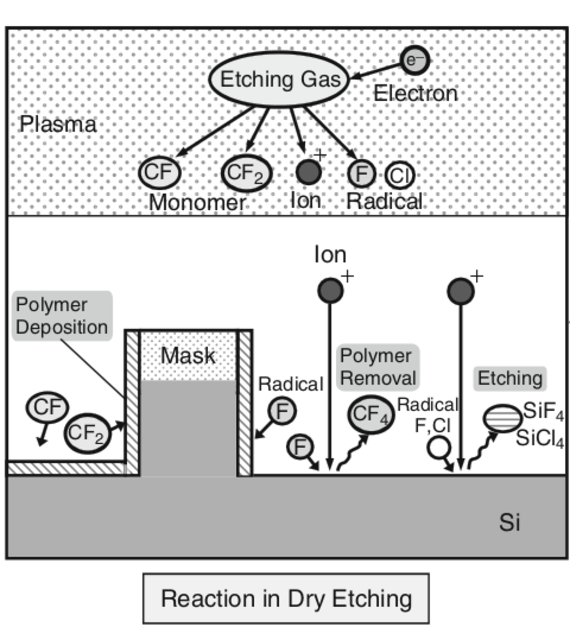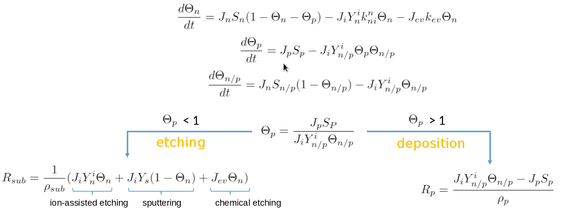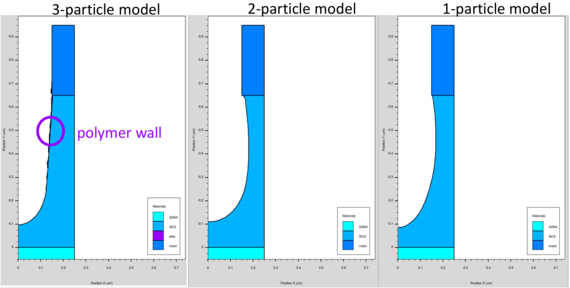 |
|
||||
BiographyFrâncio Souza Berti Rodrigues was born in 1991 in Caxias do Sul, Brazil. He received his Bachelor's degree in Engineering Physics from the Federal University of Rio Grande do Sul (BSc, 2015). Subsequently, he received his Master's Degree in Microelectronics Manufacturing from the same university (MSc, 2018). After finishing his studies, he worked in research and development for the packaging industry before joining the Institute for Microelectronics in September 2019. He is currently pursuing his doctoral degree, researching high performance numerical approaches for Technology CAD within the scope of the Christian Doppler Laboratory for High Performance TCAD. |
|||||
Feature Scale Modeling of Fluorocarbon Plasma Etching
Precise modeling of the great diversity of mechanisms involved in plasma etching in order to predict the resulting final structure is a great challenge. Fig. 1 shows the multitude of etching and deposition mechanisms that arise in a typical fluorocarbon-based plasma etching process. This ability to selectively etch and deposit layers is essential to the fabrication of the high aspect ratio (HAR) structures widely used in modern integrated circuits and high capacity memory technologies. Designing these non-linear, multi-parameter processes to achieve the desired final structure remains expensive and time-consuming and the use of computational modeling can greatly speed up and reduce the cost of the development process.
We have developed a model to describe fluorocarbon dry etching via Silvaco's Victory Process open modeling library. The complex chemical reactions, which involve many radicals and their variants, have been abstracted to just three classes of effective particles: neutrals, ions and polymers. The neutrals play the role of the etchants, the ions are responsible for the physical sputtering and reactive ion etching mechanisms and the polymer particles are responsible for the protective layer deposition. We used the system of Langmuir adsorption kinetics equations shown in Fig. 2 to capture this dynamic. The coverages reach their own steady-state level very quickly compared to the etch timescales, and thus, a steady-state condition can be safely applied. During each time step, the particles impinge on the surface, and the neutrals and polymers may stick and cover it. If etchants are dominant, then the surface is etched, and if the polymers are dominant, film deposition occurs.
This model has been implemented and applied to silicon-dioxide-via, which was etched with argon and fluorocarbon gases. Fig. 3 shows the comparison between our model and the currently available models of Victory Process for a via etch geometry. The 1-particle model from Fig. 3 simulates only the physical sputtering mechanisms, while the 2-particle model only simulates the ion-assisted etching without polymer deposition. Neither is capable of modeling highly anisotropic processes, as shown by the clear rounding of the sidewalls, which makes them unable to simulate HAR profiles. Our model addresses these issues and takes the deposition of polymers on the sidewalls into account. It thus has a more realistic etching rate due to the polymer interplay and is capable of simulating HAR profiles.

Fig. 1: The etch gas is dissociated in the plasma to generate reactive species, such as ions and radicals and monomers, which form the basis of polymers. These species reach the wafer surface and react with the etch target material. Complicated competing mechanisms of etching and deposition take place at the wafer surface, with the monomers forming a protective polymer layer and the radicals etching the exposed surface. This selective protection of the surface creates a very anisotropic process that is suitable for creating HAR structures.

Fig. 2: The set of Langmuir adsorption kinetics equations used to describe the coverage of feature surfaces by the incoming ions, polymers and neutrals. If polymers dominate, the surface is covered with a protective layer. When the amount of polymers is low, the surface is etched by ion-assisted, physical sputtering and chemical etching mechanisms.

Fig. 3: The comparison between our 3-particle model and the previously available 2-particle and 1-particle models from Victory Process. The sidewall polymer deposition is represented by the alloy material in purple. Our model is capable of taking polymer deposition into account and of simulating HAR profiles with vertical sidewalls.


